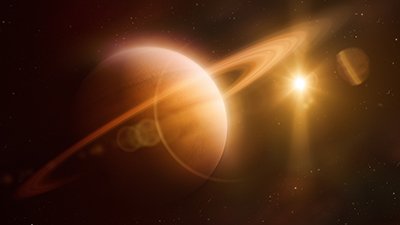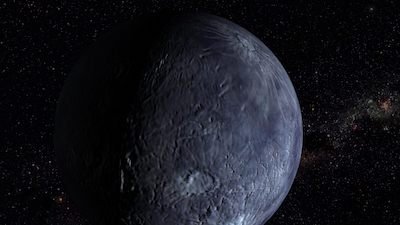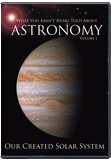Nibiru and Planet X
Nibiru is a supposed rogue planet that is moving about in the solar system, soon to wreak havoc on the earth, supposedly in line with biblical prophecy. I’ve discussed Nibiru in two previous articles. In the first article, I traced the origin of the name Nibiru and how the idea came to the forefront of various doomsday scenarios, often associated with biblical prophecy. I also briefly discussed the many purported photographs of Nibiru, and then I explained the true identity of one of the Hubble Space Telescope images that supposedly captured Nibiru. In the second article, I explained several other supposed images of Nibiru that NASA and astronomers allegedly have suppressed. Promoters of Nibiru’s existence often call it “Planet X,” and use articles and astronomers’ comments about Planet X to support their claims about Nibiru. In this article, I examine these claims about Planet X.
The Original Planet X
It is vital to understand that there is no single Planet X. Rather, that title has been recycled several times, and this has led to much confusion on the matter, because supporters of Nibiru have used astronomers’ discussion of other Planet Xs to bolster their arguments for Nibiru, even using “Planet X” as an alternate name for Nibiru. The term Planet X was coined by the French astronomer Gabriel Dallet in 1892, the X standing for the unknown, x, in algebraic equations. In 1781, William Herschel discovered the planet Uranus, the seventh planet orbiting the sun, when he accidentally stumbled upon it while looking through his telescope. From its observed motion, astronomers calculated its orbit around the sun. However, within a few years, there were discrepancies between the computed and observed positions of Uranus. By the early 1840s, astronomers began to consider the possibility that the discrepancies could be explained by the gravity of an eighth planet orbiting the sun, beyond the orbit of Uranus. The British mathematician John Couch Adams and the French mathematician Urbain Le Verrier computed positions for this hypothetical planet. Working from Le Verrier’s prediction, the German astronomer Johann Gottfried Galle discovered the planet Neptune in 1846. However, over the next few decades, astronomers thought they saw further, subtle discrepancies in Uranus’ orbit, so they speculated that a ninth unknown planet might exist, hence Dallet’s choice of Planet X for a tentative name. It was strange that Neptune appeared unaffected by Planet X. Astronomers made various predictions of Planet X’s position, and searched for it several times. The most extensive search was at Lowell Observatory in Flagstaff, Arizona, where the search continued for years in several spurts. Success finally came early in 1930, when Clyde Tombaugh spotted a tiny spot in different positions on photographs of the sky taken six nights apart. Computation of its orbit revealed that it was orbiting the sun much beyond the orbit of Neptune.
However, almost immediately astronomers realized there was a problem. Pluto, the name chosen for this new ninth planet, appeared very faint, suggesting that it was tiny. If it were so small, then it was unlikely that Pluto had enough mass to produce gravitational tugs on Uranus sufficient to account for the discrepancies in its orbit. Indeed, this was confirmed in 1978, when the American astronomer John Christy discovered Charon, a natural satellite, or moon, orbiting Pluto. Its orbital motion permitted measurement of Pluto’s mass, which turned out to be 0.2% of the earth. Such a disappointing small mass was the primary reason the International Astronomical Union decided in 2006 that Pluto no longer was a planet.
What would account for the discrepancies with Uranus’ orbit?
What would account for the discrepancies with Uranus’ orbit? There was much disagreement on the matter. The discrepancies were very small, on the order of the errors in observation, suggesting that the discrepancies might not be real but just noise in the data. At least one astronomer proposed that the discrepancies were due to galactic tides. Still, some astronomers kept with the idea that there may be yet another planet, or even more than one planet, beyond the orbit of Neptune. One notable example was the American astronomer Robert Sutton Harrington, who assisted Christy in the calculation of Charon’s mass. Harrington pursued this thesis, computing possible positions of this new “Planet X,” and, again, there were searches with null results.
New Planet Xs
The situation appeared to change briefly in 1983. That year, the orbiting InfraRed Astronomical Satellite (IRAS) imaged most of the sky in the infrared during its 10-month mission. This was the first time this was done, and it turned up many new interesting objects, including one that was reported in the press as a possible planet orbiting far from the sun,1 much as Harrington has suggested. Alas, this new object turned out to be several very distant faint galaxies and dust emission that were so close together as to appear as a single source. Many people promoting Nibiru on the Internet repeat or paraphrase a small part of a sentence from the 1983 news report:
as large as Jupiter and as close to Earth.2
Of course, they interpret this massive planet so close to earth as the supposed planet Nibiru moving about in the inner solar system. The people promoting this news story as evidence of Nibiru’s existence never state that this news report was in 1983, or that this initial possibility was quickly retracted. Nor do they put that little piece of a sentence in context. The article listed several possible things that this newly discovered object might be, including that it might be a distant planet in our solar system. Expanding on that idea, the article said,
The most fascinating explanation of this mystery body, which is so cold it casts no light and has never been seen by optical telescopes on Earth or in space, is that it is a giant gaseous planet, as large as Jupiter and as close to Earth as 50 billion miles. While that may seem like a great distance in earthbound terms, it is a stone's throw in cosmological terms, so close in fact that it would be the nearest heavenly body to Earth beyond the outermost planet Pluto. “If it is really that close, it would be a part of our solar system,” said Dr. James Houck of Cornell University’s Center for Radio Physics and Space Research and a member of the IRAS science team. “If it is that close, I don't know how the world's planetary scientists would even begin to classify it.”3
Note that I italicized the small quote often used and bolded and underlined the minimum distance that this possible planet could have been to the earth, as thought at the time. That distance is more than 50 times the earth’s distance from the sun, placing it far beyond the orbit of Neptune, the most distant known planet. And that was the closest possible distance—it likely was much farther. That puts a totally different spin on it, doesn’t it? As I mentioned already, astronomers soon correctly identified what the new object was, showing that it was not a planet after all.
In all of this, some promoters of Nibiru suggested that Harrington somehow was silenced by NASA and other nefarious agents. What about the discrepancies that Harrington’s predictions were based on? The 1989 flyby of Neptune by Voyager 2 permitted a more accurate measurement of Neptune’s mass. When the correct mass of Neptune is included, the discrepancies in Uranus’ orbit are accounted for.4
Nemesis
Within the evolutionary paradigm, in 1980 a team of researchers proposed that the mass extinction at the end of the Cretaceous period 65 million years ago, an event that wiped out the dinosaurs, was caused by a large meteoroid impact.5 Three years later, two paleontologists suggested that over the past 250 million years there were 12 mass extinction events with an average length of time between the events being 26 million years.6 Though they didn’t identify the mechanism for the periodic mass extinctions, the authors thought an astronomical cause was most likely. Within months, two papers appeared in the same issue of Nature arguing that a faint star orbiting the sun in a distant orbit periodically stirred up the Oort cloud (the hypothetical source for long period comets), causing a rain of comets to enter the inner solar system each time, greatly increasing the probability of impacts on earth that could lead to mass extinctions.7 This hypothetical star soon acquired the nickname “Death Star” and the more popular name “Nemesis,” from the spirit of divine retribution in Greek mythology for those consumed by hubris.
A dim star orbiting the sun at great distance would have very little proper motion, thus eluding detection.
What is the nature of Nemesis? That is not clear. One team suggested it was a minimal mass star, a red dwarf, while the other team thought it was a brown dwarf, a failed star, with too little mass to be a star, but much more mass than a typical planet. From earth, Nemesis would appear as a very faint star. If it exists, astronomers unknowingly have already photographed Nemesis. However, astronomers would have failed to understand its true nature, because its distant orbit around the sun would result in very low proper motion. Proper motion is the apparent shift in position that stars have due to their motion and the sun’s motion through space. Nearby stars tend to have high proper motions, so candidates for parallax measurements to determine distance accurately are identified by their large proper motion. However, a dim star orbiting the sun at great distance would have very little proper motion, thus eluding detection.
Some proponents of Nibiru refer to reports of Nemesis, but they fail to mention how far away Nemesis, if it even exists, would be. Hence, the hypothetical object Nemesis often is confused with Nibiru.
New Ninth Planets
Over the years, there have been numerous suggestions of additional planets orbiting the sun beyond Neptune. Often these hypothetical planets have received the informal recycled designation of Planet X. Arguments for these various Planet Xs stem from the perceived need to explain peculiarities in the orbits of known distant objects in the solar system. For instance, there may be alignments of the orbits of long period comets that some astronomers have claimed are due to the gravity of additional planets orbiting the sun far beyond Neptune.8 Or consider trans-Neptunian objects (TNOs), asteroids orbiting the sun beyond Neptune. Because of its mass and size, Neptune’s gravity ought to dominate TNOs, but several TNO orbits are detached, not coming close to Neptune. Some astronomers think an additional distant Planet X could explain these orbits.9 Finally, early in 2016, two astronomers noted that there was a clumping in the orientation of some TNOs’ orbits. This led them to propose that there is a massive planet orbiting far from the sun to account for this clumping.
At various times, supporters of Nibiru reference press accounts of these latest Planet Xs. Clearly, those who do so fail to grasp the nature of these things. One important thing they don’t understand is how far away these hypothetical planets are. If any of these Planet Xs were real, it would take centuries for them to travel from their current locations into the inner solar system to wreak havoc on the earth. Furthermore, no one is suggesting that these Planet Xs have orbits that will bring them into the inner solar system.
Conclusion
Supporters of Nibiru continue to misidentify unrelated objects, both real and hypothetical, to this supposed rogue planet. Nibiru does not exist. I urge Christians not to be involved in this nonsense.
Footnotes
- “Mystery Heavenly Body Discovered,” Washington Post, December 31, 1983, https://web.archive.org/web/20080201141420/http:/spider.ipac.caltech.edu/staff/tchester/iras/washington_post_mystery_object.html.
- Ibid.
- Ibid., emphasis added.
- E. Myles Standish Jr., “Planet X: No Dynamical Evidence in the Optical Observations,” The Astronomical Journal 105, no. 5 (May 1993): 2000–2006, http://articles.adsabs.harvard.edu/cgi-bin/nph-iarticle_query?1993AJ....105.2000S&data_type=PDF_HIGH&whole_paper=YES.
- Luis W. Alvarez, Walter Alvarez, Frank Asaro, Helen V. Michel, “Extraterrestrial Cause for the Cretaceous-Tertiary Extinction,” Science 208, no. 4448 (June 6, 1980): 1095–1108, doi:10.1126/science.208.4448.1095.
- David M. Raup and J. John Spekoski Jr., “Periodicity of Extinctions in the Geologic Past,” Proc. Natl. Acad. Sci. USA 81 (February 1984): 801–805, http://www.pnas.org/content/81/3/801.full.pdf.
- Daniel P. Whitmire, and Albert A. Jackson IV, “Are Periodic Mass Extinctions Driven by a Distant Solar Comparison?,” Nature 308 (April 19, 1984): 713–715, doi:10.1038/308713a0; and Marc Davis, Piet Hut, and Richard A. Muller, “Extinction of Species by Period Comet Showers,” Nature 308 (April 19, 1984): 715–717, doi:10.1038/308715a0.
- J. Horner and N. W. Evans, “Biases in Cometary Catalogues and Planet X,” Mon. Not. R. Astron. Soc. (2001): 1–16, https://arxiv.org/pdf/astro-ph/0205150.pdf.
- “The Mystery of Planet X,” AllesOverSterrenKunde.nl, January 12, 2008, http://allesoversterrenkunde.nl/!/actueel/artikelen/_detail/gli/the-mystery-of-planet-x/.
Recommended Resources

Answers in Genesis is an apologetics ministry, dedicated to helping Christians defend their faith and proclaim the good news of Jesus Christ.
- Customer Service 800.778.3390
- Available Monday–Friday | 9 AM–5 PM ET
- © 2026 Answers in Genesis






